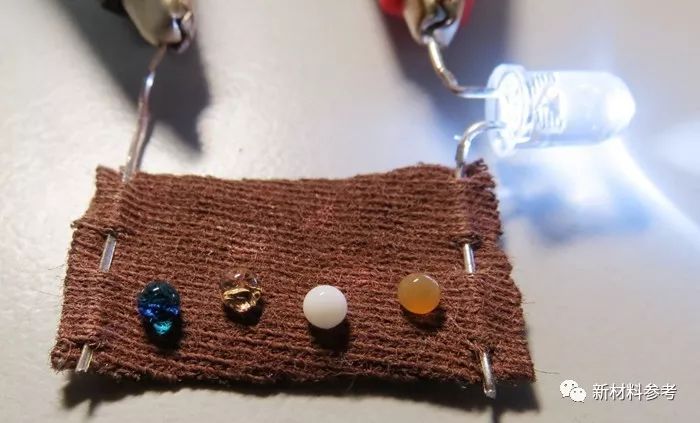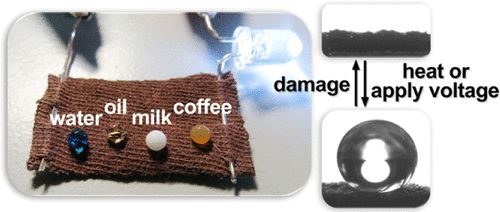C&EN
by Manny Morone
APRIL 12, 2018

A slew of different liquids bead up on this strip of cotton fabric because of a coating that researchers applied to it (droplets from left, water containing a blue dye; oleic acid, which is the main component in olive oil; milk; and coffee). Also, with the coating, the fabric can conduct electricity, allowing the researchers to incorporate it into an electrical circuit that turns on a light-emitting diode (top right). Junqi Sun’s team at State Key Laboratory of Supramolecular Structure & Materials made this multitasking coating by first applying a layer of copper that’s about 10 µm thick. This layer gives the threads their conductivity. Then the researchers dip the copper-coated cotton in an ethanol bath that contains two chemicals with fluorinated side chains. The chemicals bind to the copper surface, and because of the molecules’ highly water- and oil-repellent side chains and the copper’s rough surface texture, the fabric staves off a wide variety of liquids. Fabrics with coatings like these could one day be used with wearable electronics and sensors.
Credit: Xiang Li.
这种织物在将来很有用哟,现在智能面料是最火的开发热点,好多跨国巨头专门开发这种新应用,所以适应智能穿戴设备的面料开发也成为热点。
下面是文章原文出处:Read the paper:
ACS Appl. Mater. Interfaces
2018
文章摘要

Electrically conductive fabrics with liquid repellency and corrosive resistance are strongly desirable for wearable displays, biomedical sensors, and so forth. In the present work, highly electrically conductive and healable superamphiphobic cotton fabrics are fabricated by a solution-dipping method that involves (NH
4
)
2
PdCl
4
-catalyzed electroless deposition of Cu and the subsequent deposition of a mixture of fluorinated-decyl polyhedral oligomeric silsesquioxane (F-POSS) and 1
H
,1
H
,2
H
,2
H
-perfluorooctyltriethoxysilane (POTS) on cotton fabrics. Because of their superamphiphobicity, the resulting fabrics are self-cleaning and exhibit excellent resistance against corrosive acidic and basic solutions. The as-prepared fabrics have a sheet resistance of ∼0.33 Ω·sq
–1
and show excellent electromagnetic interference shielding and electrothermal heating ability. Because of the preserved F-POSS and POTS molecules, the fabrics can conveniently and repeatedly restore the loss of superamphiphobicity by applying a low voltage of 1.0 V or heating the fabrics at 135 °C to facilitate the migration of the preserved F-POSS and POTS to the surface of cotton fabrics. The integration of healable superamphiphobicity into the Cu-coated fabrics generates multiple functional cotton fabrics with excellent conductivity, electromagnetic interference shielding, self-cleaning ability, and significantly enhanced durability.
点原文链接可进入ACS的期刊
需要原文的可联系F叫兽
F叫兽打算以后在周末转发一些类似的材料发展方面最新的信息,就不翻译了,敬请持续关注






